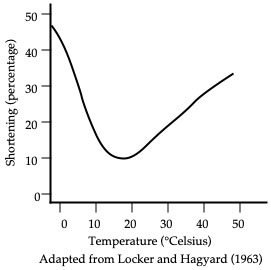Objectives:
(1) To identify factors responsible for ensuring acceptable tenderness of meat.
(2) To show how different biochemical and other postmortem factors affect meat tenderness.
(3) To acquaint the student with the various commercial processes and equipment used to tenderize meat.
Reading material: Principles of Meat Science (4th ed.), Chapter 5, pages 91 to 107.
How to make meat more tender:
- Cause the sarcomeres to be longer.
- Disrupt the integrity of the myofibrils.
- Disrupt the integrity of the connective tissue.
Cold shortening — process whereby sarcomeres shorten due to cold-induced nervous response. Results in tougher meat.
Source: Locker, R. H., and C. J. Hagyard. 1963. A cold shortening effect in beef muscles. J. Sci. Food Agric. 14:787-793. doi:10.1002/jsfa.2740141103
To prevent cold shortening:
(1) Speed-up drop in pH in muscle (anaerobic glycolysis: glycogen —> lactic acid; muscle pH 7.0 —> 5.6).
and/or
(2) Slowdown drop in muscle temperature.
How to make meat more tender:
Cause the sarcomeres to be longer
Prevent cold shortening
- Subcutaneous fat thickness — 0.10 inch in lamb; 0.25 inch in beef. Slows down temperature drop in muscle.
- High temperature, pre-rigor chilling — 16°C for 16 hours immediately after slaughter.
- Electrical stimulation — 550 volts, 2 to 6 amps, 15 times in one minute. Very rapid drop in muscle pH and much quicker onset of rigor mortis.
Stretch the sarcomeres
- Texas A&M Tenderstretch — suspension by the obturator foramen. Hindleg acts as a cantilever.
- Stouffer’s Stretching Devices — TAMU Tenderstretch plus clamps and stretching rods.
- TenderCut™ — bones and connective tissues are cut around muscles to allow stretching.
Disrupt the myofibrils
Increased activity of endogenous enzymes
Calpains – stored in the cytosol near Z-lines and require calcium to be activated
Calpastatin – regulates calpains; the higher the calpastatin levels and activity, the less breakdown of myofibrils.
- Cooler aging — storage for 1 to 6 weeks at 0-3°C.
- High temperature, post-rigor chilling — Storage at 20°C for 24 hours. Same effect as 2°C for 14 days.
- High temperature, pre-rigor chilling — 16°C for 16 hours.
- Electrical stimulation — rapid pH decline ruptures lysosome and releases cathepsins.
- Calcium chloride infusion/injection — pre-rigor infusion or post-rigor injection of a solution of calcium chloride into muscle. Causes increased activity of calpains.
Addition of exogenous enzymes
Tropical plant enzymes
Heat activated: Swift’s Pro-Ten (inject into live animal) or Adolph’s Meat Tenderizer (sprinkle on meat)
Papain (papaya), Bromelin (pineapple), Ficin (fig), Actinidin (kiwi)
Severance of myofibrils
- Electrical stimulation — violent contractions cause myofibril tearing.
- Blade or needle tenderizer — machines with multiple blades and/or needles that penetrate meat as it passes through on a conveyor. First machine was Jaccard (most people call the process “Jaccarding”)
- Mechanical severance — scoring, dicing, cubing, grinding or chopping.
- Hydrodyne™ — placing meat in a sealed water-filled chamber and setting off an exposion. Destroys most of the Z-lines to greatly improve tenderness.
Disrupt connective tissue
Use of exogenous enzymes
- Marination with salt and vinegar — 2% solution of NaCl plus acetic acid in water
- Rhozyme: use of fungal enzyme: Aspergillus oryzae
- Tropical plant enzymes
Severance of stromal proteins
- Blade or needle tenderization
- Mechanical severance
Conversion of collagen to gelatin
- Moist-heat cookery: cook for a long time with steam generation — Braise, Stew, Simmer
Review of Material — What the student should know:
(1) The differences in the mechanisms of the processes used to tenderize meat.
(2) Some of the commercially available processes and equipment to tenderize meat.
Links to related sites
Author: J.W. Savell
Updated February 23, 2021
